Pussytoes are common roadside flowers. To find them look along ditches or hillsides next to the road, or open areas in the woods. If you look for them, you’ll most likely find some as they tend to form mats. Flowering pussytoes are quite common in mid-Spring to Summer.
Several species of pussytoes, or everlastings as they may be called, are native to the Eastern US. Pussytoes are differentiated by their leaf structure and leaf arrangement.
Our example here is called Smaller Pussytoes, Antennaria neodioica. Its characteristics include the presence of one prominent vein instead of three veins in the basal leaves, and basal leaf shoots that are not long and prostrate. Also, the basal leaves turn upward at the tips which come abruptly to a point.
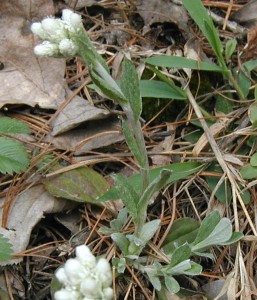
Basal shoots in the image above are turned upward and not prostrate to the ground. The abruptly pointed tip and single leaf-vein can also be seen. (Photo taken 18Apr2010.)
A very similar plant, Field Pussytoes, A. neglecta, has one-veined, spoon-shaped basal leaves that do not come to a point and longer basal leaf shoots that lie prostrate. Newcomb’s Wildflower Guide provides line drawings and descriptions that help to differentiate several pussytoes.
The flower parts are indistinguishable and comprised solely of disc flowers. Ray flowers are not present in this member of the Compositae, the composite or daisy family. The small white flowering head appears fuzzy or woolly, as do the leaves and stems.
Pussytoes cluster their flowers at the top of a woolly stem that might reach 6 to 12 inches tall. Six to eight composite flowers are very bright white.
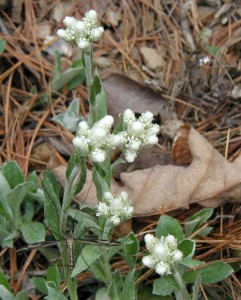
Several pussytoes flower heads and a resting crane fly. (Photo taken 18Apr2010.)
Small leaves on the stem are lance-like and are held close to the stem. Basal leaves are somewhat larger than the stem leaves and have a broad tip that makes the basal leaf spoon-shaped.
The common name pussytoes is fitting as the flowers do look like pussycat toes and the flowers clustered together remind one of a cat’s paw.
Sometimes the pussytoes have a dozen or more flower heads clustered together.
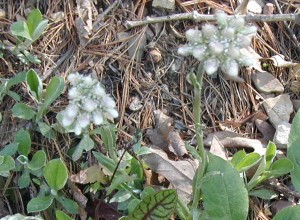
(Photo taken 30Apr2010.)
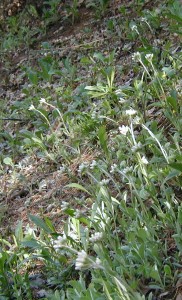
Patch of pussytoes at the side of the road. Their white flower heads lean toward the sun. (Photo taken 30Apr2010.)
Pussytoes will continue to be seen flowering at the edge of the road or forest for weeks to come. They have an ability to form mats, where several plants grow densely in a small area.
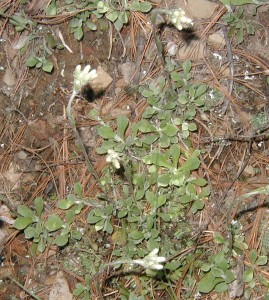
The basal rosettes of pussytoes are close enough together and so dense as to form mats. This mat-forming ability makes pussytoes more noticeable along the roadside. (Photo taken 30Apr2010.)
![Reblog this post [with Zemanta]](http://img.zemanta.com/reblog_e.png?x-id=adc32ffb-e43f-4474-919b-111d6358024f)
We have Antennaria neodioica growing in our yard and at fist it was nice to see a few flowers in the spring! However, it is now taking over large areas of the yard and completely killing of the grasses. The yard is just a cut hayfield and we do not even want a manicured lawn but these pussytoes are destructive!
The weed killers I have tried seem to have no effect! How do we get rid of them! RDC
Hey Roger,
I guess I would try a shovel. Even if you don’t get all the roots, or seeds that may have blown away by now, you’ll get some of the mature plants out of your way so they won’t bother you next year.
The mat-like growth habit lets the pussytoes out-compete a number of other plants and it seems as if you’re observing that in your yard.
Good luck! Let us know how you do!